The mythical beast: 1/48 Wyverns from Classic Airframes and Trumpeter
The Wyvern has to be one of the strangest airplanes to ever grace a carrier deck. The first turboprop, its ten years of gestation and failure as the FAA's strike force paid off for the rest of aviation by solving the problems of controlling and operating turboprops.
I have for some reason always liked this airplane, it has a grace of its own. In the 1980s I did an ID Models vacuform (which was determined to be a "what if" model when shown at OrangeCon in 1988). Then the very nice Dynavector vacuform in the mid-90s, then the Classic Airframes kit in 2003 (sort of a limited-run injection molded Dynavector model), and finally the Trumpeter version in 2006. It's one of Trumpy's better kits (most likely because it didn't start life as a Trumpy project, but was an acquisition from a company that failed to launch successfully), Nice petite surface detail, lots of ordnance, good decals, separate flaps, wing-fold option, etc. If you like weird airplanes, that kit's a good candidate for a lot of fun.
W.E.W. “Teddy” Petter began development of what would become the Wyvern as his last project at Westland before leaving for English Electric where he would design his masterpiece, the Canberra jet bomber. Petter's objective was to develop a long-range carrier-based day fighter with the ability to carry a torpedo or bombs as appropriate for a secondary role as an anti-shipping strike aircraft. The original design would have had the engine mounted amidships, a layout that had been tried for the Westland F.7/30 prototype of 1934. The favored engine at this point was the Rolls-Royce Eagle, a 24-cylinder liquid-cooled “H” type like the Napier Sabre, designed for an ultimate output of 3,500 horsepower. Further development was made official when the Naval Staff issued specification N.11/44, written around the Westland proposal. A mockup with the mid-mounted engine and nose-mounted cockpit found little support from the service pilots who would fly it, so a second mockup was created with the engine in the nose and the cockpit atop a significant hump in order to obtain a 15-degree angle of view over the nose for deck landing. By June 1944, the design was known as the W.34, though it was officially known as the N.11/44 until the adoption of the name “Wyvern” in 1947.
By August 1944, Westland began investigating the possibility of changing the powerplant to a turboprop. However, six Eagle-powered prototypes were ordered in November 1944. The planned turboprop was the Rolls-Royce RB.39 Clyde, which Rolls-Royce expected to deliver in December 1945. The N.11/44 prototype, which was the biggest British single-seat naval fighter type at the time, required a double fold of the wing, with the tips folding down in order to have clearance on the hangar decks of RN carriers. In order to launch from a deck, the airplane required a contraprop, which was developed by Rotol (8-blade) and DeHavilland (6 blade). This in turn led to a very large vertical fin to provide directional stability.
The first Turboprop Wyvern flew on January 16, 1949, powered by a R-R Clyde. While the Clyde exceeded initial performance estimates, it suffered from a variety of problems, not the least of which was that Rolls-Royce was committed to other engine projects, which kept them from focusing on solving the Clyde's problems. The Armstrong-Siddeley Python was the only turboprop of the necessary power that could be used for the Wyvern. This change added at least two years to the development cycle as the engineers struggled to create a throttle control that would allow the engine to be rapidly throttled back for a carrier landing, or rapidly throttled up to make a go-around, the solution being an inertia control unit (ICU) that was, unfortunately, mechanically complex.
The Wyvern finally appeared from development as the S.Mk.4, and began to be delivered to RNAS Ford in May 1953 to equip 813 Squadron. These aircraft did not have the definitive engine control unit and thus were not carrier-compatible until these units were installed in the summer of 1954. The first operational Wyverns went aboard HMS Albion in September 1954, where it was discovered their problems were not over, as there were a series of flameouts during catapult launch as a result of fuel starvation under high-g loading while the aircraft were with Albion during a Mediterranean cruise. The Wyverns were offloaded at Hal Far, Malta, and remained there until March 1955 when they returned to England. A final design of the ICU/ECU unit solved the flameout problem. 813 and 827 Squadrons embarked aboard HMS Eagle in May 1955 for a second Mediterranean cruise, which gave the Wyverns some 1,500 operating hours and 1,000 landings, after which the aircraft was considered proven.
813 and 827 Squadrons returned from the Mediterranean and decommissioned in November 1955. They were replaced by 830 and 831 Squadrons which activated in January 1956. 830 Squadron went aboard HMS Eagle that May, destined to be the only unit to fly the Wyvern in combat, when their nine aircraft participated in six days of strikes against Egyptian military targets in the Suez Canal Zone in October-November 1956 as part of Operation Musketeer, the Anglo-French “intervention” in what was called “the Sinai War,” though that was really part of a conspiracy by the two western powers, working with Israel, to regain control of the Suez Canal following its nationalization by Egypt in 1955.
813 recommissioned in October 1956, giving the FAA three strike squadrons. With the decommissioning of 830 and 831 Squadrons in January and February 1957, 813 was the last Wyvern operational unit, embarking on HMS Eagle in July 1957 for a tour that lasted until March 1958. 813 decommissioned at Ford on March 29, 1958, which marked the end of active service for the Wyvern. 33 had been lost to all causes during its operational life. The survivors were all melted down during 1959, and the only Wyvern in existence today is the Wyvern Mk.1 VR137, which was never actually flown.
The Classic Airframes kit has the dark blue spinner, the Trumpeter the red spinner.
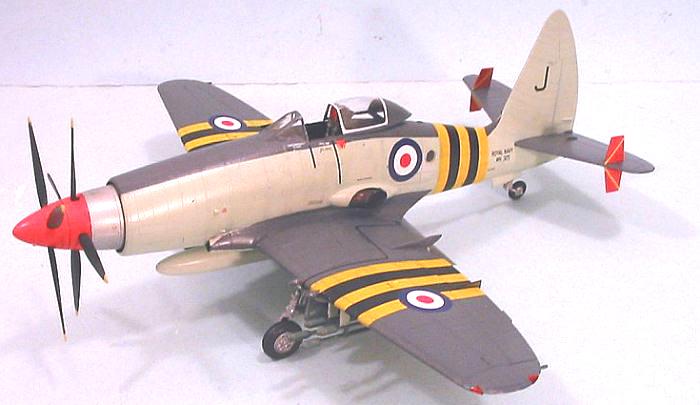
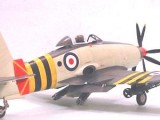
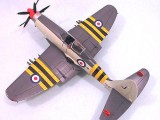
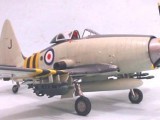
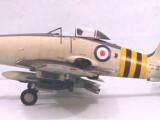
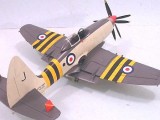
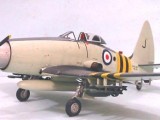
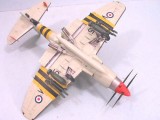
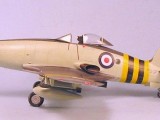
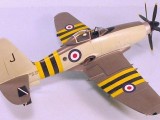
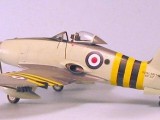
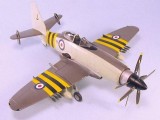
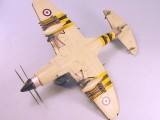
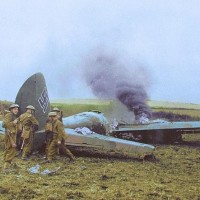


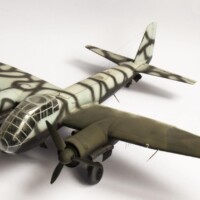
Which kit gave you the least problems...Trumpeter or Classic Airframes?
Hi Craig, I built the Classic Airframes kit (it's in my gallery) and found it very troublesome needing lots of filler and some serious fit issues with the wing fold area, I would recommend the Trumpeter kit, if I remember rightly they also do two options of an early or late version though I don't know what the differences are.
N.
I don't recall there being a wing-fold option on the Classic Airframes kit, but it might have been modified after I got my kit. From my review of the Classic Airframes kit build:
As with most limited-run kits, there are some fit problems with this Wyvern model. These are primarily with the fit of the wing sub-assembly to the fuselage sub-assembly. The wing as assembled per instructions is approximately 1/32" too thin to fit exactly with the fuselage. I solved this with some 20-thou Evergreen sheet, cut to make braces that I shoved into the wing immediately behind the wheel wells, and some 15-thou sheet shoved into the space between the roof of the wheel wells and the upper wing half. This increased the wing thickness and modified the airfoil so that it fit perfectly to the fuselage. I also had to modify the fore and aft joints of the lower wing and the rear joint of the fuselage to get a good fit. A bit of Mr. Surface 500 cleaned up all these joints. The other problem was with the vertical fin, which is attached to the fuselage with a joint that runs through an area where there are no panel lines. I filled that seam with cyanoacrylate glue, sanded it down, and then needed two coats of Mr. Surfacer 500 and a further coat of Mr. Surfacer 1000 to finally hide this seam.
Other than this, there was no problem in the construction. I suggest that you attach the inner main gear doors - which are fully retracted after the main gear is lowered - before proceeding further to glue the upper wing halves to the lower wing part. This way, you can trim the doors to fit the wheel well easily, and get a good solid joint by gluing from the interior surface.
As provided in the kit, the main gear legs will assemble so that they stick straight down. This is wrong! The Wyvern gear has about a 20-degree forward angle, so that the axles are just ahead of the leading edge of the wing when viewed from directly above when in the down position. I test-fit and modified the base of the gear leg to get a solid joint without any real problem.
I also cut the resin prop spinner and re-glued it so that the contraprop blades would not be directly in line with each other, since this was something the airplanes only displayed when the blades were turned manually on the ground.
From my review of the Trumpeter kit:
Due to the excellent production design, the Trumpeter Wyvern assembles as easily as a Tamiya kit. With careful assembly, I was able to produce this model without using any putty or Mr. Surfacer on seams, something I haven’t done with any model in a very long time.
As with the Tamiya Corsair, the wing when extended is weak, and needs some extra stiffening. I did this the same way I do with the Tamiya Corsair - I cut some evergreen strip and glued it inside the center wing, giving extra “grab area” for the glue for the outer wing when it is attached to the positioning pins. Test-fitting the wings in the folded position reveals that this will work, but the wing will be pretty weak. Even with the extra evergreen sheet providing added strength, once the model is assembled it would be advisable to handle it by the fuselage only to avoid the possibility of breaking the wings.
Like the Skyraider, Dauntless and Helldiver, the Westland Wyvern was not normally seen on the ground with the wing air brakes extended, so I assembled those closed. If you attach these to the wings in their component parts, you will get much better fit, because the assembled air brake is not as thick in section as the wing where it attaches. Attach the lower part to the lower wing, then attach the upper part to the upper wing, and then finally attach the forward section, and all will fit properly.
The Wyvern was hardly ever seen with the Fowler flaps open on the ground. However, as with most kits that have separate flaps, the flaps fit better in the lowered/open position than they do in the closed position, so I attached them open.
The one thing that Trumpeter got wrong is the shape of the propeller blades. Rather than provide the blades used on the production aircraft, they are the more "paddle-shaped" blades used on the prototype. To correct them, they should be more pointed, which is simple to fix with a sanding stick, and I think it took me about 5-6 minutes to do both sets of propellers.
Surprisingly (to me at least) the contra-rotating gizmo the kit provides actually works. Not accurately, since the rear prop rotates at about half the speed of the forward blades, but you can vary the pose of the blades. I would not do this frequently, and I suspect if this was ever motorized the plastic gears would grind away and break in a matter of minutes, but for setting the pose of the model they are adequate.
Another inaccuracy is that kit would have you pose the inner gear doors hanging open. The gear doors on the Wyvern cycled down to lower the gear, then the inner doors cycled back up to the fully-closed position. It’s easy to do this by cutting off the hinges, and the doors fit perfectly to the wheel well opening.
The cockpit provides adequate detail, particularly since everything ends up painted black. The seat provided in the kit is OK, but a resin seat will be better since this is the one item in the cockpit that will catch the eye of the viewer. I had an extra Martin-Baker Mk.2 seat from the Classic Airframes Canberra (no need to stick it in the cockpit when you can’t see it when finished) and used that.
I stopped assembly when the main airframe was complete, minus the outboard stabilizing fins on the horizontal stabilizer, the flaps, or any drop tanks or other underwing load, all of which would be painted separately and attached after painting and decaling were completed.
Love those kits, i have built the Classic Airframes and have the Trumpeter which looks a little more detailed to me
It's a lot more detailed - you'll love it.
Always a choice subject, but one you don't see too often. That curved dorsal spine gives the aircraft an Orca-like menace.
It's definitely a strange looking plane, and it makes a great looking model, so ugly it's beautiful.
I have this kit, the Trumpeter, and I can't wait to put it together. I'm waiting for a Ryan XF2R-1 Dark Shark from Czech Models to add it to my SCD (Something Completely Different) collection. Love your build!
Great work on these two, Tom. I too have loved this plane ever since I said "What's that?" while holding a Frog Wyvern in a hobby shop as a kid.